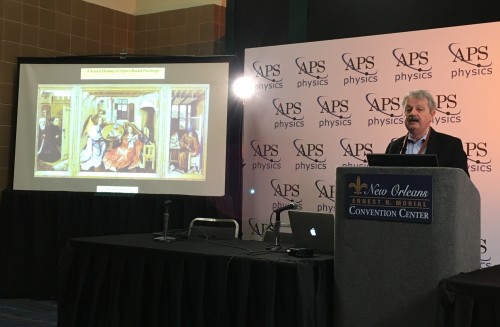
Artists’ secrets: Charles Falco describes how artists used optical lenses. (Courtesy: Tushna Commissariat)
By Sarah Tesh in New Orleans, Louisiana, US
As a physicist who likes to sketch and paint, I love it when art and physics come together. I was therefore excited to see that the APS March Meeting had a variety of talks on the subject. Charles Falco from the University of Arizona in the US told us about his work with the famous artist David Hockney. On a trip to see the 15th century painting The Arnolfini Marriage by Jan van Eyck, Hockney decided that the chandelier was too detailed to have been done freehand. So Falco and Hockney began looking at the intricate parts of paintings by artists through the ages and found that they essentially cheated.
Through focal length and depth-of-field calculations, Falco showed that artists had used optical lenses to project the complicated parts onto the canvas before painting them. They suggest that this has been happening since the 1400s and is a technique used by artists such as Hans Holbein (who painted the iconic portraits of Henry VIII) and Johannes Vermeer (whose work includes Girl with a Pearl Earring). Obviously, they still possessed huge amounts of skill, but it definitely makes me feel a bit better about my own skill level.
In another talk, Marc Walton of Northwestern University described some of the state-of-the-art methods used to analyse paintings. Materials-analysis techniques are particularly useful, non-destructive ways of authenticating artwork, studying their response to environmental conditions and establishing their “compositional fingerprint”. Walton focused on how high-resolution hyperspectral imaging and X-ray fluorescence (XRF) in particular can reveal hidden images. For example, he and his team looked at parchment bindings from the 16th century and found that the covers had been scraped clean of their original text. By using hyperspectral imaging and XRF they were able to “see” what the parchment originally had written on it. They have also used the methods to look at Vincent van Gogh’s three paintings The Bedroom to study how his style developed and changed.
Guidelines
Show/hide formatting guidelines
this text was deletedwhere people live in harmony with nature and animals</q>
Some text